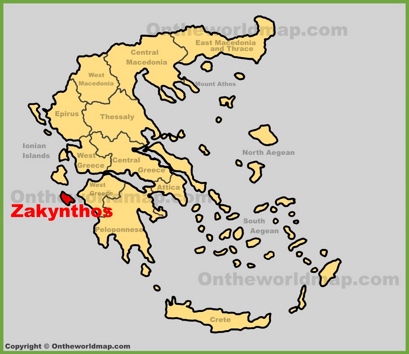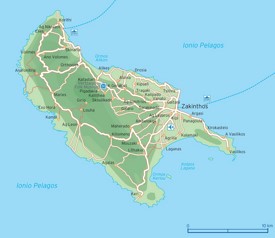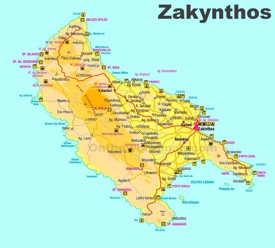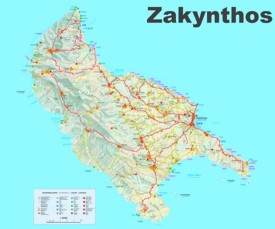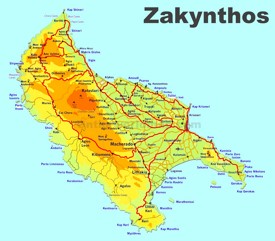Zakynthos Maps
Online Map of Zakynthos
About Zakynthos
Zakynthos (also known as Zante) is the third-largest of the Ionian Islands, located in the eastern Ionian Sea. The island covers 156 square miles and has a population of approximately 41,000 residents. Zakynthos Town, the capital and main port, is situated on the east coast and features neoclassical arcaded buildings along the waterfront, rebuilt after the devastating 1953 earthquake that destroyed most structures on the island.
The island's most famous landmark is Navagio Beach (Shipwreck Beach), located on the northwest coast and accessible only by boat. The beach features white sand in a cove surrounded by towering limestone cliffs, with the rusting wreck of a smuggler's ship that ran aground in 1980 on the sand. The beach, viewed from the clifftop viewpoint above, has become one of the most photographed locations in Greece. The cliffs along the northwest coast contain numerous Blue Caves, sea caves with brilliant blue water created by light refraction, accessible by boat from the port of Agios Nikolaos.
The southern part of the island, particularly the Bay of Laganas, is one of the Mediterranean's most important nesting sites for the endangered loggerhead sea turtle (Caretta caretta). The National Marine Park of Zakynthos, established in 1999, protects the nesting beaches and marine area, with strict regulations during nesting season (May-October) including restrictions on beach access at night and boat traffic in designated areas. The conflict between conservation efforts and tourism development has been ongoing and controversial.
The mountainous interior and western part of the island remain largely undeveloped and forested, in contrast to the intensively developed eastern and southern coasts. The traditional mountain village of Keri in the southwest offers views toward the Peloponnese. The Venetian influence is evident in the island's architecture and culture; the Venetians called Zakynthos "the Flower of the Levant" due to its lush vegetation. The Venetian Castle (Kastro) above Zakynthos Town, though damaged by earthquakes, offers views across the town and eastern coast.
Zakynthos was the birthplace of Dionysios Solomos (1798-1857), Greece's national poet and author of the lyrics to the Greek national anthem. The Solomos Museum in Zakynthos Town is dedicated to his life and work. The Church of Saint Dionysios, the island's patron saint, contains his relics in a silver reliquary. The monastery of Agios Georgios Krimnon near Macherado in the island's interior is an important pilgrimage site.
The island's economy is heavily dependent on tourism, with the Laganas area being one of Greece's most developed resort zones, known for intense nightlife. This has created environmental concerns, particularly regarding the turtle nesting beaches. Zakynthos International Airport provides extensive connections to Athens and direct international flights during summer. The island is accessible by ferry from Kyllini on the Peloponnese. Local products include olive oil, wine, and nougat (mandolato). The island experiences significant seasonal variation, with winter population much reduced from summer peaks.
The Facts:Region: Ionian Islands.
Capital: Zakynthos (city).
Towns and villages: Zakynthos, Alykes, Arkadioi, Artemisia, Elatia, Laganas.
Population: ~ 41,000.
Area: 156 sq mi (405 sq km).
Maps of Greece
Cities of Greece
Greek Islands
Peninsulas of Greece

